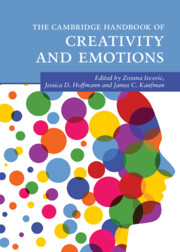Book contents
- The Cambridge Handbook of Creativity and Emotions
- Cambridge Handbooks in Psychology
- The Cambridge Handbook of Creativity and Emotions
- Copyright page
- Dedications
- Contents
- Figures
- Tables
- Contributors
- Acknowledgments
- Creativity and Emotions
- Part I Methods in the Study of Creativity and Emotions
- Part II The Development of Creativity
- Part III Emotions and the Creative Person
- Part IV Emotions and Creative Products
- 17 Emotional Creativity
- 18 Affective Factors in Dark Creativity
- 19 For Emotion’s Sake … The Centrality of Emotions in the Art Experience
- 20 The Affective Benefits of Creative Activities
- 21 Everyday Creativity as a Pathway to Meaning and Well-Being
- 22 Creative Arts Therapies
- 23 Developing Emotion Abilities through Engagement with the Arts
- Part V Emotions and Creativity at School and Work
- Index
- References
18 - Affective Factors in Dark Creativity
from Part IV - Emotions and Creative Products
Published online by Cambridge University Press: 16 February 2023
- The Cambridge Handbook of Creativity and Emotions
- Cambridge Handbooks in Psychology
- The Cambridge Handbook of Creativity and Emotions
- Copyright page
- Dedications
- Contents
- Figures
- Tables
- Contributors
- Acknowledgments
- Creativity and Emotions
- Part I Methods in the Study of Creativity and Emotions
- Part II The Development of Creativity
- Part III Emotions and the Creative Person
- Part IV Emotions and Creative Products
- 17 Emotional Creativity
- 18 Affective Factors in Dark Creativity
- 19 For Emotion’s Sake … The Centrality of Emotions in the Art Experience
- 20 The Affective Benefits of Creative Activities
- 21 Everyday Creativity as a Pathway to Meaning and Well-Being
- 22 Creative Arts Therapies
- 23 Developing Emotion Abilities through Engagement with the Arts
- Part V Emotions and Creativity at School and Work
- Index
- References
Summary
Although recent research has begun examining the construct more widely, there exist several gaps in scholarship. One such area is the influence, association, and role of affective factors in determining whether and to what extent an entity engages in dark creativity. After introducing concepts like negative and malevolent creativity, this chapter reviews the existing literature on the link between affective factors and creativity. Thereafter, the features of dark personality traits, like psychopathy, are examined with reference to affective considerations such as low empathy in producing original harm. Owing to the relationship between dark creativity and moral concerns, we also examine how moral emotions like guilt and shame (or lack thereof) may contribute to an understanding of such creativity. The chapter concludes with suggestions for future research and avenues for interdisciplinary studies.
- Type
- Chapter
- Information
- The Cambridge Handbook of Creativity and Emotions , pp. 340 - 357Publisher: Cambridge University PressPrint publication year: 2023
References
- 2
- Cited by



